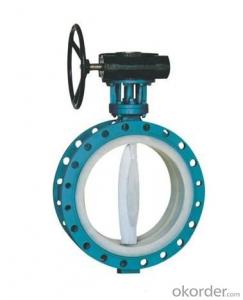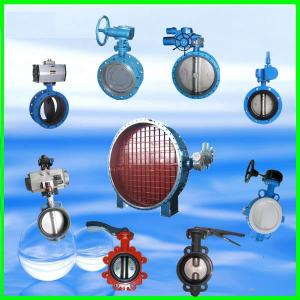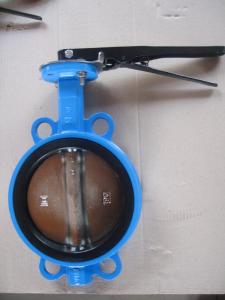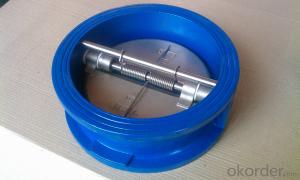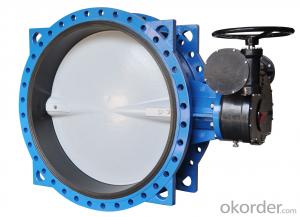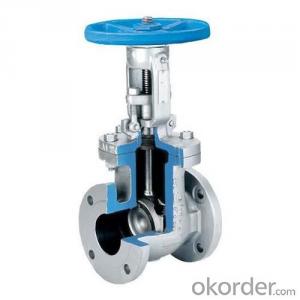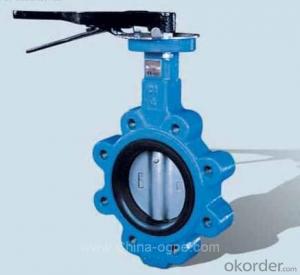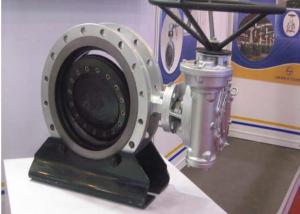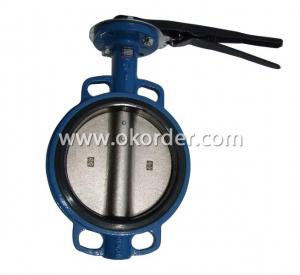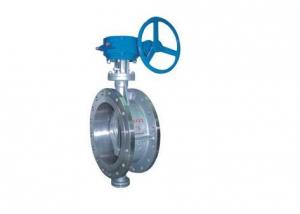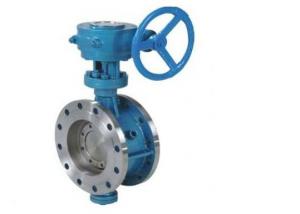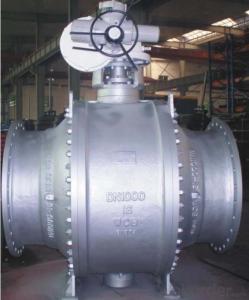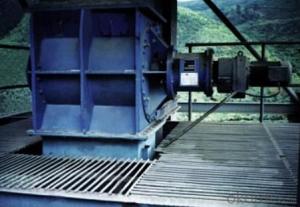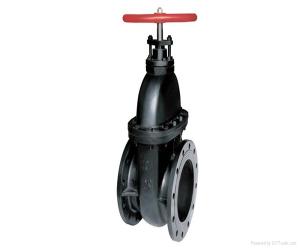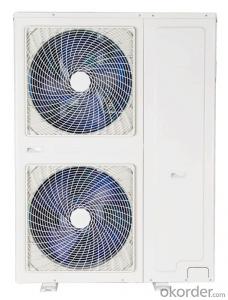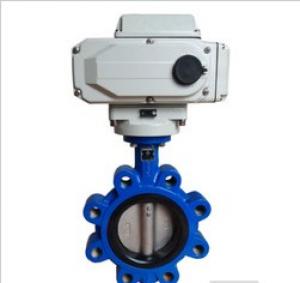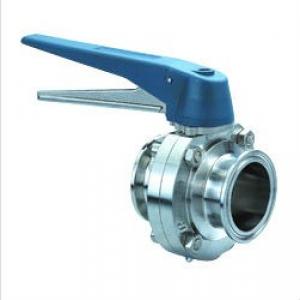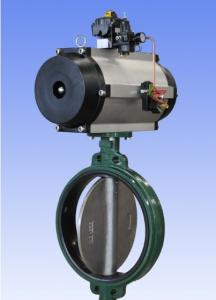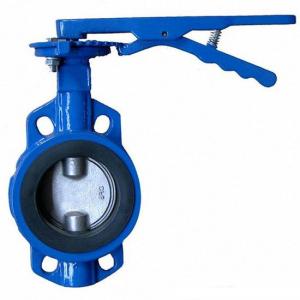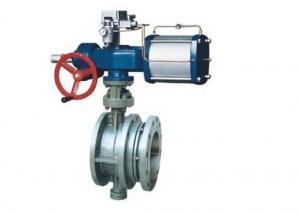Butterfly Valves Ductile Iron Wafer Type DN630
- Loading Port:
- China main port
- Payment Terms:
- TT OR LC
- Min Order Qty:
- 100 set
- Supply Capability:
- 80000 set/month
OKorder Service Pledge
OKorder Financial Service
You Might Also Like
1. Manual Wafer Butterfly Valve Description:
A butterfly valve is a valve which can be used for isolating or regulating flow. The closing mechanism takes the form of a disk. Operation is similar to that of a ball valve, which allows for quick shut off. Butterfly valves are generally favored because they are lower in cost to other valve designs as well as being lighter in weight, meaning less support is required. The disc is positioned in the center of the pipe, passing through the disc is a rod connected to an actuator on the outside of the valve. Rotating the actuator turns the disc either parallel or perpendicular to the flow. Unlike a ball valve, the disc is always present within the flow, therefore a pressure drop is always induced in the flow, regardless of valve position.
2.Main Features of the Manual Wafer Butterfly Valve
a)Cast hole. Flange connection meet ANSI 125/150# DIN PN10/16 BS4504 PN10/16 in the meanwhile.
b)Soft seat. Replaceable. Increase of service life.
c)Double half shaft without pin.
d) Square and short neck. Easy to stick scutcheon and cost saving.
Design & Manufacture acc. to API 609,MSS SP-67,BS5155,BS EN593.
Face to Face acc. to DIN3202,API609,MSS SP-67,BS5155,BS EN558.
Top Flange acc. to ISO5211.
Pressure test acc. to API598,BS EN12266-1,DIN3230,BS5155.
Side Flange acc. to DIN2501,ANSI125/150,AS2129,BS4504,BS10D&E,JIS10K
3. Manual Wafer Butterfly Valve Images:

4.Manual Wafer Butterfly Valve Specification:
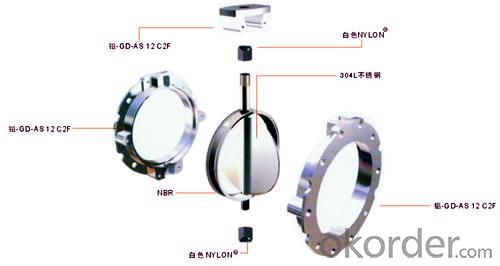
5.FAQ
1. What is manual wafer butterfly valve?
A: Wafer style is the more common of the two and is less expensive than the lug style. The wafer style butterfly valve is just about the standard. It ís so common that no one even bothers to use the word "wafer" when ordering a butterfly valve. It is taken for granted that if a butterfly valve is ordered, a wafer style will be received.
2. How about the Installation of the Wafer Style Butterfly Valve?
A: Butterfly valves are installed by inserting the valve between two flanges using bolts or studs and nuts to hold it all together. This type of installation, of course, makes it impossible to disconnect just one side of the piping system from the valve. That benefit is received using the lug style valve.
3. What is the working principle of manual wafer butterfly valve?
A: A butterfly valve is from a family of valves called quarter-turn valves. In operation, the valve is fully open or closed when the disc is rotated a quarter turn. The "butterfly" is a metal disc mounted on a rod. When the valve is closed, the disc is turned so that it completely blocks off the passageway. When the valve is fully open, the disc is rotated a quarter turn so that it allows an almost unrestricted passage of the fluid. The valve may also be opened incrementally to throttle flow.
- Q:What is the difference between wafer (flangeless) type and LUG type of butterfly valves?
- WAFER butterfly valve is the valve is divided into LUG (ears) with and without LUG, ordinary LUG without clip on 12 points in the direction of valve is generally two to four bolt holes was not, whereas the LUG of butterfly valve cross dispersed in a circle. Bolt hole. With LUG all bolted through the LUG, so that the butterfly valve and the clamp on the two flange connection is more solid, you check the valve picture, it is easy to understand
- Q:19 years ago i had a valve repair and now im due to have heart valve replacement. I heard that the metal valve make noise has anyone who has had the metal valve have this type f problem or any other problem with the metal valve it would be a great help if anyone could answer
- Do you want to have kids or have more kids? This is going to be the biggest question you have to answer. The tissue valve will require no treatment after the replacement, other than another replacement in 10-15 years or whenever the valve starts to fail. The mechanical valve will most likely last the rest of your life, but will require the use of anticoagulants that would make any future pregnancy extremely risky. As to the sound many patients complain about hearing the valve clicking in times when it is very silent (dead of night etc.) Most find that keeping a Radio or tv on at a low level solves the problem, Id say in my experience about 50% of patients complain about hearing the clicking. The other issue is that using tissue valves, it is a slightly riskier operation every time you re-open someones chest, due to scar tissue formation. So instead of say 1-3% risk it might be 5% if the person is young and healthy. This is important since the tissue valve will only last 10 maybe 15 years. The atrial thrombus complicates matters, however which valve are they replacing? It might be possible to remove the thrombus at the same time as doing the valve. If not, mo matter what you will be taking warfarin, so the vavle choice really will not matter that much.
- Q:valve adjustment 2001 chev prism 1.8L
- valve adjustment . you need to know the fire order. the gage between the stem. rotators the cranshaft. it could be cold start. cylinder need to be bottomed center.
- Q:I have a good set of #142 Pontiac heads with small diameter valves. I want to have the heads enlarged to accept the larger Pontiac valves, and I have the larger exhaust valves out of #13 heads and the larger intakes from 6X8 heads. The valves appear ok and shiny on the stems
- If the valve is burnt there is no longer something you're able to do with it yet replace it. in the event that they simply desire cleansing up you could lap them in with a lapping compound the threat with this is which you would be able to desire to visual exhibit unit which you don't get close to to the sting of the valve, this is once you will finally end up with a burnt valve. The valve should not be flush with the valve seat this is plenty to close and the warmth of combustion could have an more advantageous effect on the textile.
- Q:The difference between vertical and horizontal butterfly valves in municipal water supply
- Vertical and horizontal only installation directions and installation methods are different. Functionally, there is no difference.The main difference between the two methods of installation is that:1. horizontal can effectively avoid the high temperature radiation above the pipe. The disadvantage is that it takes up a lot of space.The advantage of the 2. vertical is that the occupation space is smaller, and it is easy to install. If the pipeline is higher, it is not convenient for maintenance.
- Q:Who was the first doctor to discover Pulmonary Valve Stenosis? Also, who was the first doctor to perform surgery for it? Please and thank you for your help.P.S. I have this condition.
- 1761 - Pulmonary valvar or valvular stenosis is one of the more common forms of congenital heart malformations and it has been extensively studied since the original description of pulmonary valve stenosis by John Baptist Morgagni in 1761. 1888 - Tetralogy of Fallot, first characterized by Dr.Etienne Fallot in 1888, is present in about 3000 children born each year in the United States. It is a combination of four heart abnormalities. Dodrill and his colleagues employed it with success for the open correction of a stenotic pulmonary valve in October 1952.
- Q:How warm is the PTFE butterfly valve?
- Ordinary PTFE clip butterfly valve normal temperature tolerance of about 120 degrees, instantly to about 150 degrees
- Q:The difference between butterfly valve and gate valve
- Wedge gate valve spool angle is generally 3~6 degrees, when forced to shut down excessive or temperature changes of the valve core is easy to die. Therefore, high temperature and high pressure wedge gate valve, in the structure have taken certain measures to prevent spool stuck. The valve in the opening and closing valve and valve seat sealing surface contact and mutual friction is always so easy to wear sealing surface, especially in close off the valve, the valve before and after the great pressure, sealing surface wear is more serious.
- Q:Seat has said to the previous owner that the car needs a new air mass meter and dump valve.I am putting a new air mass meter on it.Does it have a dump valve.I know very little on this subject.
- every turbo will have a dump valve(waste gate) to regulate the boost to the engine Dump valves are fitted to the engines of turbo charged cars and sit between the turbo outlet and the throttle body. When transitioning from a boosted state to a closed throttle state (as in between shifts), due to inertia, the turbo continues to pressurize air, but the closed throttle prevents the compressed air from entering the engine. In this case the pressure exceeds the preset spring pressure in the dump valve and the excess pressure is bled off to atmosphere. Even with a dump valve the compressed air acts as a brake on the turbo (slowing it down), because the pressure on the backside of the turbo is at a higher pressure than on the front side (and the air actually wants to flow through the turbo backwards). A blowoff valve is a more elegant solution to this problem by allowing the turbo to freewheel when the throttle is closed (equalizing the pressure on both sides of the turbo). Unlike a dump valve a blowoff valve can be used at multiple boost settings without reconfiguration. Blowoff valves are sometimes incorrectly called dump valves because they serve a similar function, but they are very different solutions to the same problem.
- Q:Not the cold and hot water shut off valves. The one with a tiny handle and it looks like a T. what does it do? should I mess with it?
- Well definitely should not mess with it, especially if you do not know exactly what it is and more important what it controls. If not water, then it could possibly be the shut off for a near by gas appliance. It would help if you described the size and color of the pipe. Maybe you could try to trace it , where does it come from and where does it go to ?
1. Manufacturer Overview |
|
|---|---|
| Location | |
| Year Established | |
| Annual Output Value | |
| Main Markets | |
| Company Certifications | |
2. Manufacturer Certificates |
|
|---|---|
| a) Certification Name | |
| Range | |
| Reference | |
| Validity Period | |
3. Manufacturer Capability |
|
|---|---|
| a)Trade Capacity | |
| Nearest Port | |
| Export Percentage | |
| No.of Employees in Trade Department | |
| Language Spoken: | |
| b)Factory Information | |
| Factory Size: | |
| No. of Production Lines | |
| Contract Manufacturing | |
| Product Price Range | |
Send your message to us
Butterfly Valves Ductile Iron Wafer Type DN630
- Loading Port:
- China main port
- Payment Terms:
- TT OR LC
- Min Order Qty:
- 100 set
- Supply Capability:
- 80000 set/month
OKorder Service Pledge
OKorder Financial Service
Similar products
New products
Hot products
Hot Searches
Related keywords
